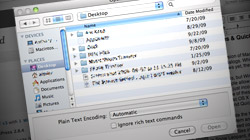The latest version of Mac OS X includes a couple important enhancements to Open/Save dialogs. While these mini windows are not quite as full-featured as real Finder windows yet, they’re getting there.
I rarely say this, but Windows beats Mac OS X in the Open/Save dialog department. Why won’t Apple allow Mac users to copy, paste, and rename files in these windows? It’s just inconvenient to open separate Finder windows every time you want to do one of these things. With that gripe out of the way, there are two new features in Mac OS X 10.6 that improve the usefulness of Open/Save dialogs – hidden files and Quick Look.
First, let’s tackle the hidden files. Macs are full of invisible files that are used by the operating system and not meant for us to mess around with. Every once in a while, though, the need comes up. We’ve already published a tutorial explaining how to show hidden files in Finder. This doesn’t apply to Open/Save dialogs, though. And in Snow Leopard it doesn’t need to – Apple already has us covered. In any Open/Save dialog, press Command+Shift+Period(.) to make hidden files visible. Pressing this keyboard shortcut a second time will hide them again.
There might only be an occasional need to show hidden files, but Quick Look can be used frequently on a daily basis. That’s why it was so frustrating in 10.5 Leopard to not be able to Quick Look files in Open/Save dialogs. This is no longer a problem in 10.6 Snow Leopard. Select any file, press Spacebar, and a Quick Look preview will appear just like in a real Finder window.
Bonus Tip:
I recently came across a cool tip I never knew about before, so I figured why not share it here just in case you weren’t aware of it either? It’s also about Open/Save dialogs, of course, but it’s not limited to 10.6. It should work in 10.5, 10.4, and earlier as well.
Let’s say you’ve got a Finder window open, showing the contents of a folder you’re working in. Then you switch to an application like TextEdit and go to save your document in that folder. But it’s not the currently-shown directory in the dialog! Don’t start manually browsing through your hard drive to get there. You can change the directory in that Open/Save dialog by dragging your working folder from the Finder window right on top of the dialog. Confused? Give it a shot for yourself to see what I mean. You’ll be glad you did – it’s such a big time saver!










December 23rd, 2009, 8:30 PM
Yes! I just stumbled on this, while using Snow Leopard 10.6.2, and went searching.
I do notice a delay in the Save As dialog box appearing. But when I discovered the advanced functionality; I was instantly okay with it.
Being a long time Explorer user and insane multi-tasker; I have missed this feature in Leopard 10.5. I now have an idea that it’s more appropriate to not use the Save As dialog box as a file organization after thought tool. Organizing my files in the proper context will keep my work flow pouring. I’m a List View user and love having the Quicklook feature in the Save As dialog. Very helpful when working with visual elements.
Another tip while were here on the Save As front; copy that file name before you click Save; it’ll probably come in handy. ;-)